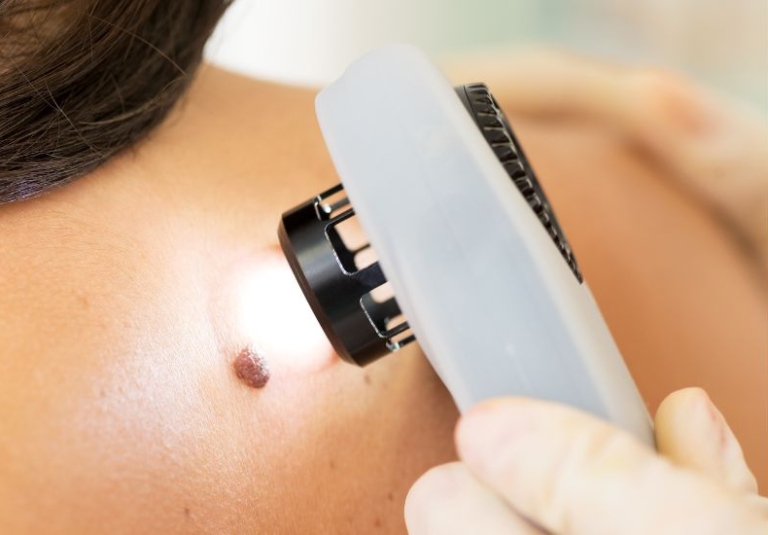
With skin cancer so common in the UK, and the incidence rate steadily increasing, it is important to know what skin cancer treatment is available near Chester.
Anca Breahna, a leading UK cosmetic surgeon whose practice specialises in skin cancer treatments explains the options and process. You can visit Anca’s skin surgery treatment page here.
Table of Contents
Every skin cancer treatment is different
For skin cancer, there is no singular treatment that will be suitable for all – this in part because the broad term skin cancer covers a wider range of specific forms of the cancer.
Ignoring the very rare versions of skin cancer, which collectively account for just a few hundred cases per year, there are three types of skin cancer – Basal Cell Carcinoma, Squamous Cell and Melanoma.
Basal Cell Carcinoma is by far the most common, accounting for around 80% of cases, and also the least serious in that it typically remains a local, confined problem. At the other end of the spectrum, Melanoma is the least common of the three but the most serious, a version of cancer that needs attention as a matter of extreme urgency.
One key problem can of course be determining whether you have any changes to the skin that could be a sign of skin cancer and, if so, which of the three types. We covered this topic in a separate post this month (ADD LINK), but the summary would be that you should have any changes checked out – be that the appearance of a new mole, or changes to existing blemishes. If a mole has grown, is irregular in shape and is prone to bleeding and crusting attention should be sought as a priority.
Removing the cancerous cells
In most cases, it is possible to remove the growth, this is done by targeting those cells and also some healthy skin cells around the area, this known as “the margin”, ensuring all the cancerous cells in the region have been taken.
It is usually then possible to close the wound by simply stitching but in some cases the size of the wound it may be necessary for a skin graft or a local flap, which is moving skin from the vicinity. If one of these options was to be required it would be discussed and the process exam-lined during consultation.
The fact that most skin cancers are for small, local Basal Cell Carcinoma means that the treatment process is relatively straightforward in most cases, especially for a specialist Plastic Surgeon.
In Less Common Incidences
The process as described above might account for most cases, but there are still many thousands of more problematic skin cancer cases each year.
For these, the approach will vary, the cancer may have spread to a wider area, it might be in a more difficult position or it might have spread to other parts of the body as can be seen in melanoma. Clearly, this becomes a very different procedure to one just targeting a local skin problem.
Treatment would first depend on a thorough microscopic analysis of the lesion. The thinner the melanoma, the more favourable the chances of a positive outcome, this is why early detection is hugely beneficial.
Scans and blood tests may be required, with CT scans now favoured over chest X-rays. If there is concern that the melanoma has spread to the lymph nodes a sentinel lymph node biopsy may be needed, where a sample is sent away for investigation to see if the melanoma has spread to the nearby lymph nodes. If it has, the remaining lymph nodes in that area may be removed in follow-up surgery.
Chemotherapy and immunotherapy can also be potential treatment options, the latter growing in prevalence with more suitable, better drugs developed.
The Healing of the Wound
As previously stated, in most cases the wound can be stitched shut directly. A follow-up appointment would ensure the wound is healing as expected.
When the area is larger or direct closure is not an option, a different approach will be required – this can be via skin graft or a flap of skin from nearby area.
To list all these options here would be to get ahead of ourselves – they are simply not necessary in the majority of cases. If such an option was required, the surgeon would detail the options and then an informed decision could be made and any questions answered.
However, if you do wish to see more detail on the closure options available to surgeons, please head to the BAPRAS – British Association of Plastic Reconstructive and Aesthetic Surgeons – website.
It Starts With A Consultation
There is a huge amount of information online, but that can be both a blessing and a curse. You can find ways to potentially check for skin cancer, you can see the whole range of treatment options, but you cannot actually know which one is suitable for you.
In searching for skin cancer treatments, you will see treatments for advanced melanoma, and yet these will account for only a small percentage of cases, far more common will be Basal Cell Carcinoma.
We point this out not to promote inaction, quite the opposite in fact. We point this out because you cannot actually achieve particularly practical online, you can gain some information but you cannot self-diagnose or determine the best treatment option.
Anyone with concerns that changes to their skin might signify some form of skin cancer should arrange for a check. This could be with your GP, equally a cosmetic surgeon with specialist knowledge in this field can perform the task.
If you would like to arrange a consultation with Anca Breahna, a leading UK surgeon who specialises in skin cancer at her NHS practice, please call 7538 012918 or email at info@ancabreahna.com
Further Reading about Skin Conditions
- Read Anca’s Blog about The Mole Guide
- Read Anca’s Blog about What Does Skin Cancer Look Like?
- Read Anca’s Blog about Treatments and Solutions for Skin Cancer







